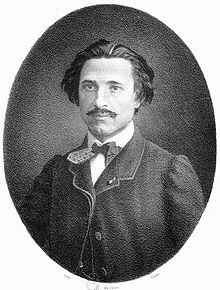Paul-Jacques-Aimé Baudry (7 November 1828 – 17 January 1886) was a French painter.
Paul-Jacques-Aimé Baudry | |
|---|---|
 Portrait published in L'Artiste, 1862 | |
| Born | 7 November 1828 La Roche-sur-Yon, France |
| Died | 17 January 1886 (aged 57) Paris, France |
| Occupation | Artist |
| Awards | Prix de Rome |


Life edit
Baudry was born in 1828 in La Roche-sur-Yon in the Vendée. He studied art under Michel Martin Drolling and enrolled in the École des Beaux-Arts in 1845.[1] He won the Prix de Rome in 1850[2] for his picture of Zenobia found on the banks of the Araxes.[3]
His talent from the first revealed itself as strictly academical, full of elegance and grace, but somewhat lacking originality. In the course of his residence in Italy Baudry derived strong inspiration from Italian art with the mannerism of Correggio, as was very evident in the two works he exhibited in the Salon of 1857, which were purchased for the Luxembourg: The Martyrdom of a Vestal Virgin and The Child.[3]
His Leda, St John the Baptist, and a Portrait of Beul, exhibited at the same time, took a first prize that year. Throughout this early period Baudry commonly selected mythological or fanciful subjects, one of the most noteworthy being The Pearl and the Wave (1862).
Once only did he attempt an historical picture, Charlotte Corday after the assassination of Marat (1861); and returned by preference to the former class of subjects or to painting portraits of illustrious men of his day: Guizot, Charles Garnier, Edmond About.[3][4]
Baudry's chief legacies were his mural decorations, which show imagination and a artistic gift for color, as may be seen in the frescoes in the Paris Court of Cassation, at the château de Chantilly, and some private residences the Hôtel Fould and Hôtel Paiva.
The decorations of the foyer of the Opera Garnier are regarded as his finest achievement.[2] These, more than thirty paintings in all, and among them compositions figurative of dancing and music, occupied the painter for ten years.[2] Baudry was a member of the Académie des beaux-arts, succeeding Jean-Victor Schnetz.
In the United States, Baudry painted two ceilings in the William K. Vanderbilt House in New York.[2][5]
Baudry died in Paris in 1886.[3] He is buried in Pere Lachaise Cemetery in Paris with a huge and highly sculptural monument.
Honours edit
- 1878 : Member of the Royal Academy of Science, Letters and Fine Arts of Belgium[6]
Legacy edit
Two of his colleagues, Paul Dubois and Marius Jean Mercié, co-operating with his brother, Baudry the architect, erected his funeral monument in the Père Lachaise Cemetery in Paris (1890).[3]
The statue of Baudry at La Roche-sur-Yon (1897) is by Jean-Léon Gérôme.
Gallery edit
-
Euterpe (détail) at the Grand foyer of the Opera Palais.
-
Zenobia Found by the Shepherds c. 1848
-
Venus and Cupid, 1849
-
Jacob Wrestling
with the Angel, 1853 -
Diana Reposing, c. 1859, Walters Art Museum
-
The Pearl and the Wave, 1862, Prado
-
Crouching Nude Male Figure at the Metropolitan Museum of Art, 1864–74
-
Seated Male Nude (recto); Crouching Male Nude (verso) at the Metropolitan Museum of Art, 1864–74
-
Study for the Muse Thalia at the Metropolitan Museum of Art
See also edit
References and sources edit
- References
- ^ Grunchec 1985, p. 147.
- ^ a b c d Sturgis, Russell (1901). A Dictionary of Architecture and Building, Volume I. Macmillan. pp. 249–250.
- ^ a b c d e Chisholm 1911.
- ^ Larousse, Pierre (1869). Grand Dictionnaire Universel [du XIXe Siecle] Francais: A-Z 1805-76. France: Administration du Grand dictionnaire universel. p. 117.
- ^ Shiedlower, Noah (20 September 2021). "William K. Vanderbilt Mansion at 660 Fifth Avenue". Untapped New York. Retrieved 31 May 2023.
- ^ Index biographique des membres et associés de l'Académie royale de Belgique (1769-2005). p 24
- Sources
- This article incorporates text from a publication now in the public domain: Chisholm, Hugh, ed. (1911). "Baudry, Paul Jacques Aimé". Encyclopædia Britannica (11th ed.). Cambridge University Press.
- H. Delaborde, Notice sur la vie et les ouvrages de Baudry (1886); Ch. Ephrussi, Baudry, sa vie et son oevre (1887). (H. FR.)
- Grunchec, P. (1985). The Grand Prix de Rome: Paintings from the École des Beaux-Arts, 1797-1863. Washington, DC: International Exhibitions Foundation. ISBN 0883970759.